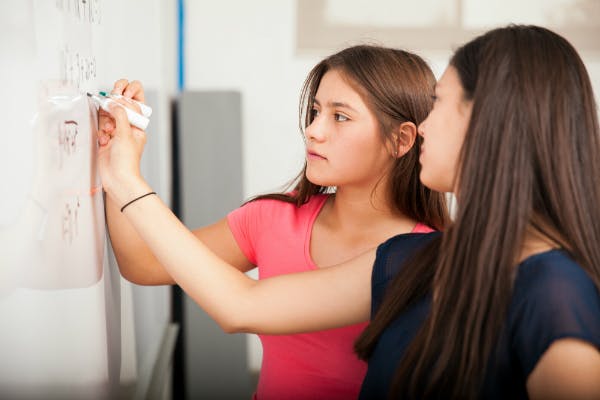15 Easy Peer Teaching Strategies to Help Students
All Posts
Bring up peer teaching in a room filled with your colleagues. You’ll almost certainly get mixed reviews, which raise lingering questions.
How can educators effectively run peer teaching activities? Are they even worthwhile, according to research?
Despite queries and concerns, peer tutoring isn’t new. The formal idea of having a student instruct skills or explain concepts to a classmate dates back to the 18th century. Looking around your classroom, you’ll likely see it happening without prompt.
To help you determine if peer teaching should play a part in your classroom, below are the pedagogy’s advantages and disadvantages. If you decide it’s worth pursuing, there are also 15 strategies for success.
Advantages and Importance of Peer Teaching

Peer tutoring activities -- whether occasional or frequent -- can deliver research-backed benefits to both the student-tutee and student-tutor, not to mention teachers.
Here are five benefits that exemplify the importance of peer teaching:
- Increased Literacy Scores -- Students who read and discuss story passages with their peers recall more content and score higher on assessments, according to an Ohio University pilot study. The researcher divided four average-reading 6th grade students into pairs. The first pair participated in peer reading activities twice a week, whereas students in the second pair read the same passages individually at the same frequency. The first pair scored higher on each reading assessment.
- Developed Reasoning and Critical Thinking Skills -- Students who work in pairs and groups typically perform better on tests that involve reasoning and critical thinking, according an oft-cited study about science education. This is largely because students must become active learners, discussing and rationalizing lesson concepts in their own words.
- Improved Confidence and Interpersonal Skills -- Many studies about peer teaching point to students building confidence and communication abilities. Pioneering research from 1988 states tutors improve self-esteem and interpersonal skills by giving feedback. Tutees realize these benefits by asking questions and receiving immediate clarification. A later study of at-risk students echoed these advantages.
- Increased Comfort and Openness -- The same 1988 study indicates that “students generally identify more easily with peer helpers than with adult authority figures.” This helps create an environment in which students are more comfortable to ask questions and work through challenging problems in an environment free from class ridicule.
- Versatility -- You can run a range of peer teaching exercises based on different subjects and objectives, possibly involving other grades and classes. Lots of ideas can lead to lots of fun for your students.
These advantages paint a clear picture why many teachers run peer tutoring activities, but you should also be aware of the difficulties associated with the practice.
Disadvantages and Limitations of Peer Teaching

There are reasons why other teachers hesitate to run peer tutoring activities, many of which concern how students interact with each other.
Here are five disadvantages to weigh against the aforementioned advantages:
- Student Inexperience -- Although you can share teaching tips and guidelines with students, they won’t become expert educators. There’s always a chance the tutor won’t properly support the tutee, giving ineffective feedback or unneeded criticism. Many peer teaching activities fail due to this, according to a book of compiled research.
- Student Hesitancy -- Pairing students together can backfire, as some may feel inferior being taught by certain peers. On the other hand, some tutees won’t put effort into the exercise, as they won’t be keen on it from the get-go. This can lead to tense relationships and, according to the same book, scarce content coverage.
- Poor Applicability -- Many detractors of peer teaching say it is more effective in post-secondary settings than elementary and high schools. After all, adults should be capable of helping each other and effectively collaborating without teacher prompts and supervision.
- Lack of Confidentiality -- In many types of peer teaching scenarios, other students can clearly see who’s the tutor and who’s the tutee. This means there may be too much transparency with regards to who’s excelling and who’s struggling. There are exceptions, though. For example, activities in which students take turns teaching.
- Parent Pushback -- You may not be the only one who identifies the above-mentioned problems. If parents learn about peer teaching from their kids, they may see it in a negative light. Unless you send an explanatory letter home, be aware there could be complaints.
Do the pros overshadow the cons? Or vice-versa?
The answer depends on factors such as the makeup of your class and maturity of your students. But if you’re leaning in favour of peer teaching, it helps to follow tips and guidelines to run successful exercises.
15 Strategies for Peer Teaching Success
When planning a peer learning exercise, refer to this list of recommendations anduse the strategies that best apply to you:
1. Role-play

Role playing proper practices will supplement your explanations, giving students clear examples and reference points about what you expect from them.
Let’s say your class is about to start a series of reading buddy activities.
After reading a passage aloud, act out a scene that focuses on giving and receiving praise and feedback. Then, explore why your comments were or weren’t effective. You can also pair students to try this activity themselves.
Sharing definitions of praise and feedback may be enough for some, but taking this simple differentiated instruction approach
2. Create a Reward System
To keep elementary students focused, openly acknowledge proper behaviour with rewards.
For example, each time a tutor provides proper feedback, give him or her a blank ticket. You can give tutees tickets every time they successfully implement feedback. At the end of each week, have students submit their tickets and hold a draw. Winners will get a small prize.
This gamifies part of the peer tutoring process, incentivizing disinterested students and further motivating those already committed.
3. Teach Tutoring Skills
Different activities call for different approaches, of which tutors should have a basic understanding. Consider running exercises to teach students about:
- Directive Tutoring -- The tutor fills the tutee’s knowledge gaps, explaining and exemplifying how to reach a specific solution. To do so, the tutor must be confident in his or her own abilities and knowledge.
- Non-Directive Tutoring -- The tutor asks open-ended questions, guiding the tutee to form his or her own conclusions about a given topic. To do so, the tutor should understand when and how to pose thought-provoking questions.
During a peer reading activity, for example, a non-directive approach can help students process content through their own words and thoughts. On the other hand, a directive approach can help students understand how specific math formulas work.
For the best results, recommend and review the appropriate approach before starting a peer teaching exercise.
4. Explain How to Give Feedback

Feedback is a core aspect of peer teaching, meaning you should instruct students how to give it. Students will inevitably give two types of feedback during peer teaching activities:
- Positive Feedback -- This acts as encouragement. Sometimes called praise, it should be honest and natural. Ask students to think of meaningful compliments they’ve received. Using them as inspiration, they can write a list of positive feedback lines. Teach them to use a line when tutees overcome hurdles or solve tough questions.
- Corrective Feedback -- This helps tutees revise their answers. When they make objective mistakes, tutors can explain what went wrong and demonstrate how to reach proper solutions.
Think of feedback as the oil to the engine that is peer teaching. Without it, activities can’t smoothly run.
5. Provide Written Prompts
Despite explaining, modeling and practicing feedback, tutors may draw blanks when the time comes.
This is typically due to nerves, especially for young students who haven’t tutored before. You can usually avoid this issue by providing a list of prompts, which include:
- Praise for when a tutee makes progress
- Feedback for when a tutee makes a mistake
- Guiding questions for when a tutee is close to reaching an answer
- Probing questions for when a tutee is trying to explain his or her thoughts
Tutors should have an easier time, resulting in helpful and informative experiences for tutees.
6. Fill Knowledge Gaps

Although prompts are useful, tutors can still get stuck on content itself. That’s why you should monitor your class, filling knowledge gaps when needed.
You can do this by acting as a tutor’s tutor.
Provide feedback, asking guiding and probing questions to lead him or her to the answer. This not only addresses knowledge gaps, but gives tutors a first-hand look at how to act.
To automate this process, you could also use a learning platform that provides adaptive feedback.
For example, Prodigy is a fun, curriculum-aligned math game that adjusts its questions -- in terms of difficulty and type of content -- to tackle trouble spots and accommodate different learning styles. It then provides feedback tailored to specific mistakes the player made.
To try it out, create your free teacher account here:
7. Allow Students to Take Turns Teaching
Pairing mixed-ability students can enforce defined tutor and tutee roles, whereas having same-ability students work together adds variety to your peer teaching approach.
This is called reciprocal peer tutoring (RPT). It was the type of peer teaching used in the aforementioned Ohio University study, and yielded positive results as participants progressed through content together.
Students can take turns tutoring. Or, they give each other praise and feedback when opportunities present themselves.
Since you won’t have to divide tutors and tutees, you’ll be able to share teaching strategies with the entire class.
8. Partner with Another Class
You can also avoid dividing your students by working with an older or younger class.
Formally, this is called cross-age peer tutoring.
If your class is the higher grade, focus on teaching aforementioned tutoring skills. If you teach the lower grade, reinforce the importance of asking questions and actively listening.
It’s an advantageous way of encouraging different age groups to socialize.
9. Select Students Who Want to, and Can, Tutor

If you decide to designate peer teaching roles, choosing tutors is harder than simply picking students with the highest grades.
Based on a frequently-referenced article from the journal of Focus on Exceptional Children, the best tutors in elementary school settings are usually those who:
- Are active class participators
- Work hard to achieve high grades
- Interact well with others, regardless of factors such as gender and socioeconomic status
It’s sometimes best to avoid asking gifted students to be tutors, according to the article. This is because they may have less empathy for students who do not easily learn, causing friction during exercises.
Or, you can pair gifted learners together.
Regardless, you should always ask: “Do you want to tutor a classmate?”
10. Focus on Active Learning
Exercises should always allow for active learning. After all, peer teaching inherently relies upon communication and collaboration between students.
This means that activities should naturally present chances for students to identify issues, ask questions and explain their ideas.
Some popular options are:
- Role plays
- Case studies
- Reading buddy sessions
- Problem-based learning scenarios
The next three points will expand upon specific active learning exercises.
11. Run Classwide Peer Editing Sessions

Introducing peer editing exercises can build applicable skills, easing students into tutor and tutee roles.
The focus is to review and critique examples of student writing. These can real or mock examples, which you display or distribute to the entire class.
Modeling each step, the exercise involves:
- Complimenting -- Students say what they like about the piece, from word choice to sentence structure and tone to organization. They should also make notes, using elements in future work.
- Suggesting -- Students make specific, yet subjective, suggestions about the piece. “It’s confusing” won’t do. “Word choice makes the fourth sentence hard to read” is better.
- Correcting -- Students point out objective grammar, spelling and continuity errors.
Working with the entire class, this kind of exercise teaches how to give praise and feedback -- essential peer teaching skills.
12. Use Think-Pair-Share Activities
Think-pair-share exercises expose students to three lesson-processing experiences, allowing them to work individually and with a tutor or tutee.
First, as the strategy’s name implies, ask students to think about a given topic or answer a specific question by themselves.
Second, pair tutors and tutees together to discuss results and findings. Tutees focus on articulating and expanding their ideas, whereas tutors encourage their partners to do so while leading them to credible answers.
Finally, have each pair share their thoughts with the rest of the class, and open the floor for questions.
These exercises vary in length, giving you flexibility when lesson planning.
13. Modify Jigsaw Activities

The jigsaw strategy is a favourite technique for many teachers, which you can alter for peer teaching.
Normally, it involves dividing a task into subtopics, assigning one to each group member. Students then work to become subtopic experts, sharing new knowledge with their groups.
For peer teaching, you can group students together as you normally would. But be sure to give each tutor-tutee pair the same subtopic to master.
Working side-by-side, they can discuss and finish activities, presenting new knowledge to their team together.
What’s more, this approach teaches students the importance of individual contributions to meeting group goals.
14. Stress Confidentiality
As you explain a given peer teaching activity, clarify why confidentiality is important. Specifically, students shouldn’t talk about their partners’ issues with friends.
To stress confidentiality, consider running a class discussion about how:
- Everyone learns at different speeds
- Adapting to feedback isn’t always easy
- Exercises are learning experiences for both tutors and tutees
- Discussing a tutor or tutee’s performance outside of an exercise, except with a teacher, can hurt their feelings
Confidentiality plays a key role in peer teaching’s ongoing success -- if students embarrass each other about trouble spots and knowledge gaps, they’ll resist participating.
15. Identify Learning Objectives

Providing clear goals for tutors and tutees usually keeps activities on track.
Tutees should be aware of the activity’s purpose. This could be to simply improve understanding of a specific concept, or to finish reading a novel.
Tutors should understand how to fulfill that purpose. This could involve asking targeted questions or offering detailed explanations.
It’s best to devote a short lesson to the process of reaching learning objectives. And before starting an exercise, make its purpose as clear as possible.
Final Thoughts About Peer Teaching
Still on the fence?
Following some of the 15 strategies, try or re-try a few peer teaching activities to see how your students act as tutors and tutees. Use the results to determine if peer teaching should or shouldn’t play an important, ongoing role in your classroom.
Even if you come to -- or already -- believe peer teaching is a practice to avoid, understanding both sides will allow you to build a more informed opinion.
It’s a win-win.
Create your teacher account on Prodigy — a fun and engaging adaptive math game that adjusts content to accommodate player trouble spots and learning speeds. Aligned to curricula across the world, it’s used by more than 2.5 million teachers and 100 million students.



